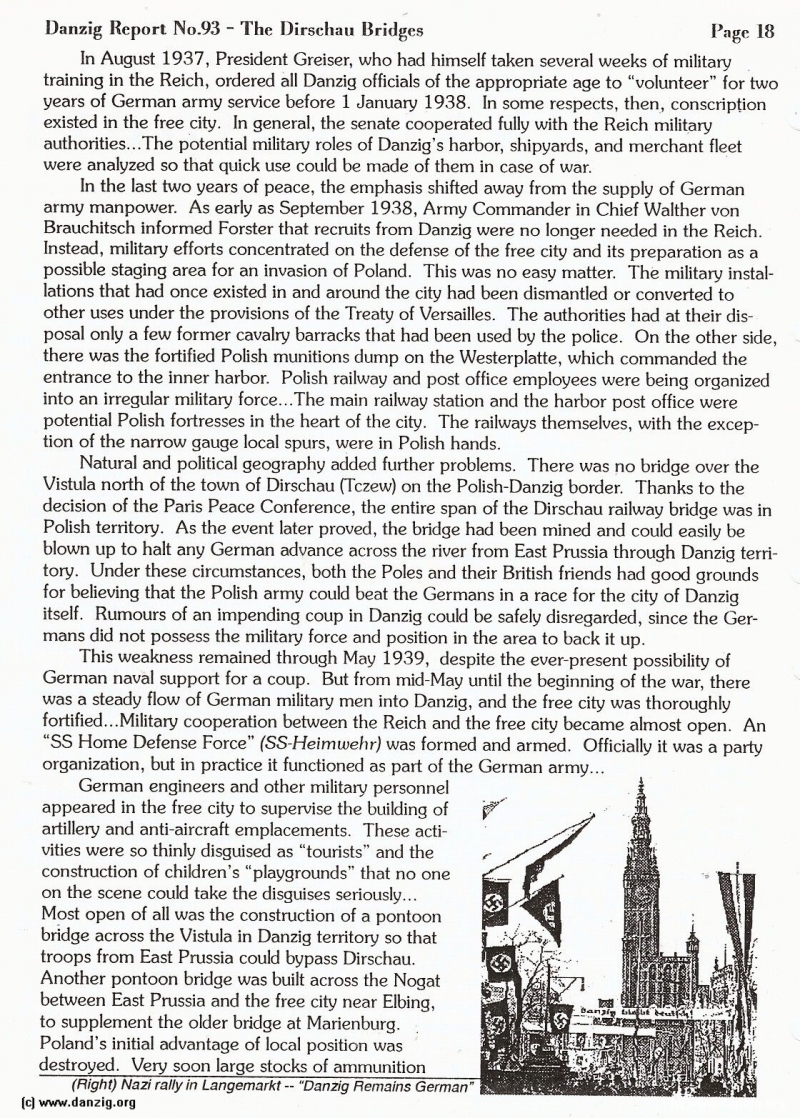
In August 1937, President Greiser, who had himself taken several weeks of military training in the Reich, ordered all Danzig officials of the appropriate age to “volunteer” for two years of German army service before 1 January 1938. In some respects, then, conscription existed in the free city. In general, the senate cooperated fully with the Reich military authorities.. .The potential military roles of Danzig’s harbor, shipyards, and merchant fleet were analyzed so that quick use could be made of them in case of war.
In the last two years of peace, the emphasis shifted away from the supply of German army manpower. As early as September 1938, Army Commander in Chief Walther von Brauchitsch informed Forster that recruits from Danzig were no longer needed in the Reich. Instead, military efforts concentrated on the defense of the free city and its preparation as a possible staging area for an invasion of Poland. This was no easy matter. The military install ations that had once existed in and around the city had been dismantled or converted to other uses under the provisions of the Treaty of Versailles. The authorities had at their disp osal only a few former cavalry barracks that had been used by the police. On the other side, there was the fortified Polish munitions dump on the Westerplatte, which commanded the entrance to the inner harbor. Polish railway and post office employees were being organized into an irregular military force.. .The main railway station and the harbor post office were potential Polish fortresses in the heart of the city. The railways themselves, with the except ion of the narrow gauge local spurs, were in Polish hands.
Natural and political geography added further problems. There was no bridge over the Vistula north of the town of Dirschau (Tczew) on the Polish-Danzig border. Thanks to the decision of the Paris Peace Conference, the entire span of the Dirschau railway bridge was in Polish territory. As the event later proved, the bridge had been mined and could easily be blown up to halt any German advance across the river from East Prussia through Danzig territ ory. Under these circumstances, both the Poles and their British friends had good grounds for believing that the Polish army could beat the Germans in a race for the city of Danzig itself. Rumours of an impending coup in Danzig could be safely disregarded, since the Germ ans did not possess the military force and position in the area to back it up.
This weakness remained through May 1939, despite the ever-present possibility of German naval support for a coup. But from mid-May until the beginning of the war, there was a steady flow of German military men into Danzig, and the free city was thoroughly fortified.. .Military cooperation between the Reich and the free city became almost open. An “SS Home Defense Force” (SS-Heimwehr) was formed and armed. Officially it was a party organization, but in practice it functioned as part of the German army...
German engineers and other military personnel - appeared in the free city to supervise the building of ‘artillery and anti-aircraft emplacements. These activities were so thinly disguised as “tourists” and the construction of children’s “playgrounds” that no one on the scene could take the disguises seriously... Most open of all was the construction of a pontoon bridge across the Vistula in Danzig territory so that troops from East Prussia could bypass Dirschau. Another pontoon bridge was built across the Nogat between East Prussia and the free city near Elbing, to supplement the older bridge at Marienburg. Poland’s initial advantage of local position was destroyed, Very soon large stocks of ammunition
Danzig Report Vol. 1 - Nr. 93 - October - November - December - 1996, Page 18.
Hits: 3561
Added: 19/07/2015
Copyright: 2025 Danzig.org

